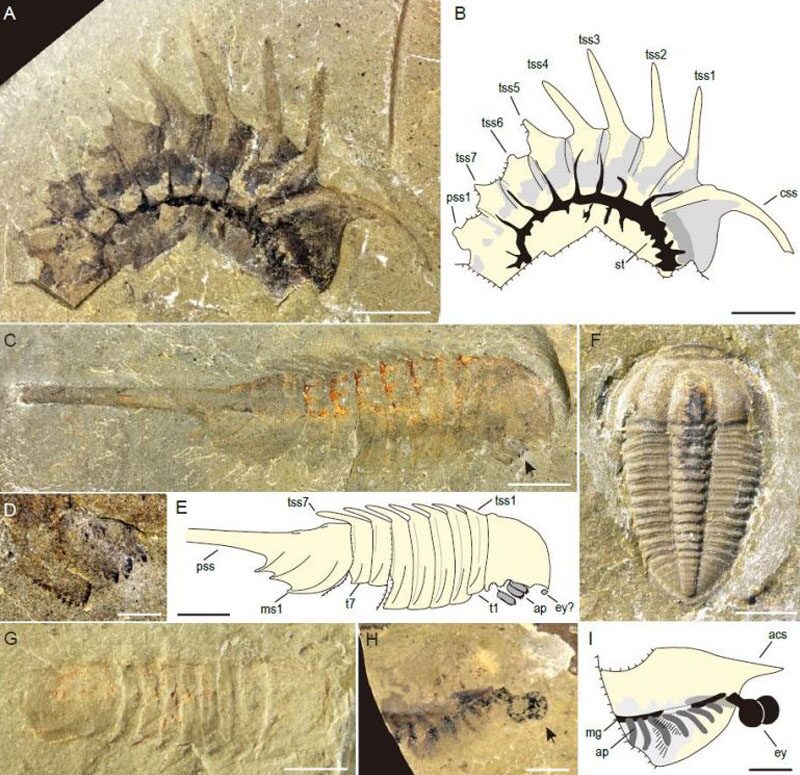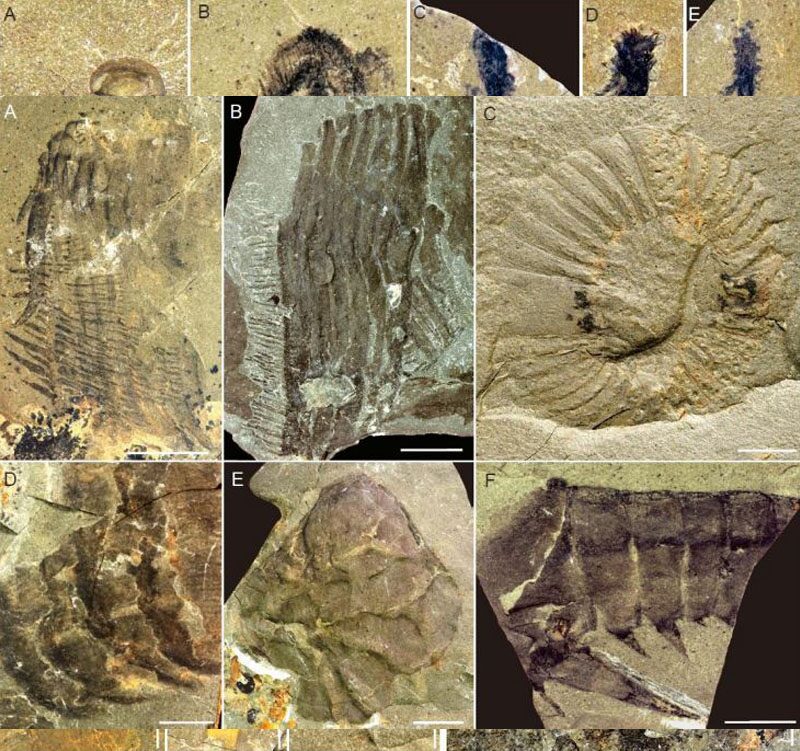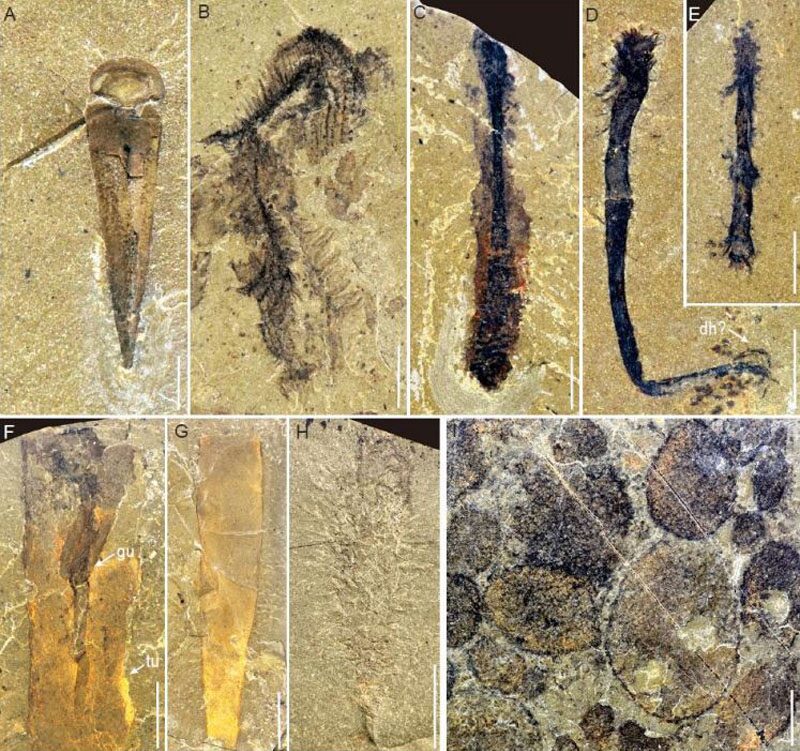พบฟอสซิล “สัตว์ขาปล้อง” หลังยุคแคมเบรียน เอ็กซ์โพลชัน-เก่าแก่กว่า 500 ล้านปี
พบฟอสซิล “สัตว์ขาปล้อง” – ซินหัว รายงานว่าคณะนักบรรพชีวินวิทยาของจีนและสหรัฐอเมริกาเปิดเผยในวารสารเนชันแนล ไซเอนซ์ ถึงการขุดพบ กลุ่มฟอสซิลสัตว์ทะเลโบราณ ที่มีความเก่าแก่ราว 504 ล้านปี ในเมืองหลินอี๋ มณฑลซานตง ทางตะวันออกของ ประเทศจีน
นายจ้าว ฟางเฉิน นักวิจัยจากสถาบันธรณีวิทยาและบรรพชีวินวิทยาหนานจิง สังกัดสถาบันบัณฑิตวิทยาศาสตร์จีน กล่าวว่ากลุ่มฟอสซิลซึ่งคณะนักวิจัยเรียกว่า “หลินอี๋ ลาเกอร์สแตท” (Linyi Lagerstatte) ประกอบด้วยสัตว์สูญพันธุ์มากกว่า 35 ชนิด อาศัยอยู่บนพื้นมหาสมุทร โดยส่วนใหญ่เป็นสัตว์ขาปล้อง

Euarthropods from the Linyi Lagerstätte. (A) Thelxiope spinosa (NIGP 176314). (B) Interpretative drawing
of (A). (C) Thelxiope tangi sp. nov., the holotype (NIGP 176315); arrow indicates the limbs. (D) Close-up of the
limbs in (C), showing the cephalic gnathobases. (E) Interpretative drawing of (C). (F) Complete exoskeleton of the
trilobite Changqingia puteata, showing the digestive structure (NIGP 176316). (G) Mollisonia symmetrica (NIGP
176317). (H) Isoxys shandongensis with appendages and a pair of eyes (NIGP 176318). (I) Interpretative drawing
of (H). Abbreviations: acs, anterior cardinal spine; ap, appendages; css, cephalic sagittal spine; ey, eyes; mg,
midgut; ms, marginal spine; pss, pygidial sagittal spines; t1–7, thoracic tergites; st, soft tissue; tss, thoracic sagittal
spine. Scale bars: 5 mm (A–D), 2 mm (G–I), 1 mm (E, F).
นายจ้าวระบุอีกว่ายังพบสิ่งมีชีวิตคล้ายฟองน้ำและที่มีรูปร่างคล้ายหนอนอีกหลายชนิดในกลุ่มฟอสซิลดังกล่าว โดยหลินอี๋ ลาเกอร์สแตท มีความโดดเด่นจากสภาพสมบูรณ์ของแขนขา ดวงตา และอวัยวะภายในของสัตว์ขาปล้อง ซึ่งช่วยให้ข้อมูลทางกายวิภาคใหม่ๆ เกี่ยวกับวิวัฒนาการช่วงต้น
กลุ่มสัตว์ที่พบในฟอสซิลนี้เชื่อว่าถือกำเนิดขึ้นบนโลกทันทีหลังเกิดปรากฏการณ์แคมเบรียน เอ็กซ์โพลชัน (Cambrian explosion) ซึ่งเป็นยุควิวัฒนาการสำคัญที่นำไปสู่การกำเนิดของบรรพบุรุษสิ่งมีชีวิตสมัยใหม่มากมาย
นายจ้าวกล่าวว่าสายพันธุ์สัตว์ทางทะเลหลายประเภทที่พบในหลินอี๋ ลาเกอร์สแตท ไม่เพียงให้ข้อมูลสิ่งมีชีวิตในยุคดังกล่าว แต่ยังเป็นหลักฐานสำคัญที่นำไปสู่ความแตกต่างเชิงสัณฐานวิทยา โครงสร้างการอยู่ร่วมกัน และการกระจายพันธุ์ทางบรรพชีวินวิทยาของสัตว์ทะเลหลังปรากฏการณ์แคมเบรียน เอ็กซ์โพลชัน

Radiodonts from the Linyi Lagerstätte. (A to E) body parts of Cordaticaris striatus. (A and B) Frontal
appendages (NIGP 176319, 176320). (C) Oral cone (NIGP 173116). (D) Set of setal structures (NIGP 173114). (E)
Smaller central element (NIGP 173112). (F) Frontal appendage of an amplectobeluid (NIGP 176321). Scale bars: 2
mm (C, D), 5 mm (A, E, F), 10 mm (B).

Representative fossils from the Linyi Lagerstätte. (A) Novakotheca weifangensis (NIGP 176324). (B)
Worm-like animal D (NIGP 176333). (C) Worm-like animal A (NIGP 176330). (D and E) Worm-like animal B,
showing the possible discoidal holdfast (dh?) (NIGP 176334, 176335). (F) Selkirkia sp., showing the coiled gut
(gu) and tube (tu) (NIGP 176322). (G) Tube of Selkirkia sp. (NIGP 176323). (H) ?Allonnia (NIGP 176326). (F)
Lingulella sp. (NIGP 176327). (I) Monospecific cluster of the sponge Diagoniella sp. (NIGP 176328). Scale bars: 2
mm (A–E), 5 mm (F–H), 10 mm (I).














